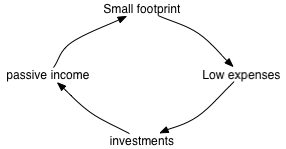(1) Negative value (consumer) process:
Stuff -> You -> Waste
(3) Neutral value:
Stuff -> You -> Stuff (-> Other Person)
Waste -> You -> Waste
(2) Positive value generation:
Waste -> You -> Stuff (-> Other Person)
In all cases, you get value from interaction with stuff. To you, it’s consumption. But how much residual value remains when you’re done? This is something that money measures well, and it’s intuitive. If you add value (2), then you’re likely making money. If you subtract value (1), you spend money. If there’s no value change (3), then the net flow of money is negligible.
Now the next thing to consider is whether an absolute (Fish-method) or relative (Jacob-method) accounting is proper. Ultimately, I think both are important. The beginner should first focus on reducing type (1) activities to achieve an absolute ecological footprint below the consumer average. Once the footprint is small, then move towards a relatively "good footprint" by redirecting consumption to type (3) and (2) activities.
Here is one of my favorite diagrams from the ERE blog (Ecological capitalism and consumer capitalism).

With this thread, we are finally able to express all of these concepts mathematically!
Low expenses = Savings Rate
Investments = SWR
Passive income = FIRE Income Index
Small footprint = Consumer Index
Savings rate and SWR are selfish measures in the sense that doing well confers no direct benefit to others. There is no real relationship between one stranger’s finances and another stranger’s well-being. But value generation (measured by income) and consumption are things that do matter, especially in aggregate where they have a meaningful impact on the world. I find this makes the new measures more interesting and exciting than savings rate/SWR, and I hope they catch on.